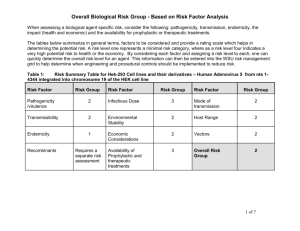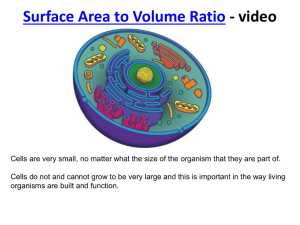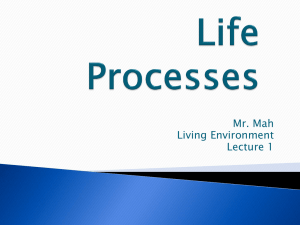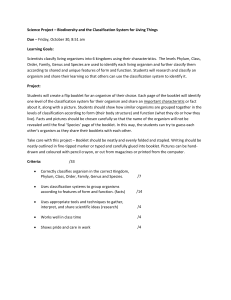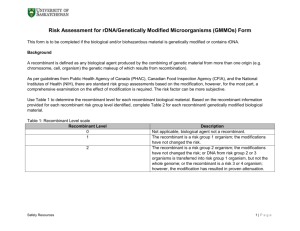Pathogen Risk Assessment Worksheet
advertisement
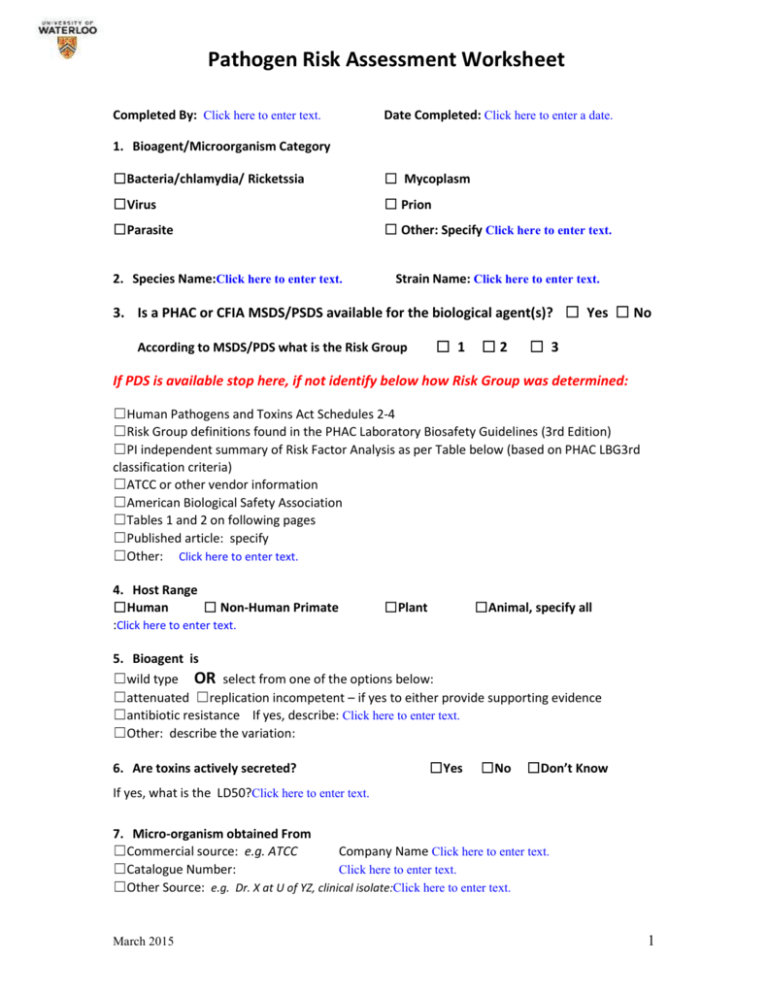
Pathogen Risk Assessment Worksheet Completed By: Click here to enter text. Date Completed: Click here to enter a date. 1. Bioagent/Microorganism Category ☐Bacteria/chlamydia/ Ricketssia ☐ Mycoplasm ☐Virus ☐ Prion ☐Parasite ☐ Other: Specify Click here to enter text. 2. Species Name:Click here to enter text. Strain Name: Click here to enter text. 3. Is a PHAC or CFIA MSDS/PSDS available for the biological agent(s)? ☐ Yes ☐ No According to MSDS/PDS what is the Risk Group ☐ 1 ☐2 ☐ 3 If PDS is available stop here, if not identify below how Risk Group was determined: ☐Human Pathogens and Toxins Act Schedules 2-4 ☐Risk Group definitions found in the PHAC Laboratory Biosafety Guidelines (3rd Edition) ☐PI independent summary of Risk Factor Analysis as per Table below (based on PHAC LBG3rd classification criteria) ☐ATCC or other vendor information ☐American Biological Safety Association ☐Tables 1 and 2 on following pages ☐Published article: specify ☐Other: Click here to enter text. 4. Host Range ☐Human ☐ Non-Human Primate :Click here to enter text. ☐Plant ☐Animal, specify all 5. Bioagent is ☐wild type OR select from one of the options below: ☐attenuated ☐replication incompetent – if yes to either provide supporting evidence ☐antibiotic resistance If yes, describe: Click here to enter text. ☐Other: describe the variation: 6. Are toxins actively secreted? ☐Yes ☐No ☐Don’t Know If yes, what is the LD50?Click here to enter text. 7. Micro-organism obtained From ☐Commercial source: e.g. ATCC Company Name Click here to enter text. ☐Catalogue Number: Click here to enter text. ☐Other Source: e.g. Dr. X at U of YZ, clinical isolate:Click here to enter text. March 2015 1 Pathogen Risk Assessment Worksheet If a reliable source (example: PDS or vendor information) is not available, use Tables 1 and 2 below to document your risk assessment. In Table 1, enter a value from 1 – 4 for each category. The values can be determined using the definitions in Table 2. When done, divide the category by 10 and round to the nearest whole number. If you are unsure how to rate each item, please take the pathogen risk assessment e-learning module located at the PHAC website. The training is only available after you have signed up for a free account. The e-learning course is also free. Table 1: Risk Group Summary Table (Choose a risk group for each category – Note these are drop down lists). For the overall risk group, add all values, divide by 10, and round to the nearest whole number. Risk Factor Risk Group Risk Factor Pathogenicity Virulence Infectious Dose Host range Availability of effective treatment or preventive measures Mode of Transmission /Route of Infection Environmental Stability Risk Group Risk Factor Risk Group Endemicity rDNA? Overall Risk Group Economic impact of release into the environment/public Table 2: Individual Risk Factor Risk Group definitions Risk Factor Pathogenicity The ability of a pathogen to cause disease. Virulence – the ease with which a pathogen will cause disease Risk Group 1 Low individual and community risk. Attack Rate – those exposed are generally not infected Population specificity – generally no disease Mortality Rate – none Immediate impact – no disease Long term impact – no disease March 2015 Risk Group 2 Mild or moderate disease, moderate individual risk, low community risk. Risk Group 3 Causes serious disease; high individual risk, low community risk: Risk Group 4 Causes severe disease / high individual risk, high community risk, Attack Rate – those exposed may be infected Population specificity – will attack only a portion of the population Attack Rate – of those exposed, many are infected Population specificity – may attack more than one portion of a population Attack Rate – of those exposed most are infected Population specificity – may not be specific to a population type Mortality Rate – 1% 10% Immediate impact – acute affects may be moderate but do not persist Long term impact – maybe be moderate Mortality Rate – 10% 50% Immediate impact – may have serious affects, which may persist Long term affects – may have serious affects Mortality Rate – 50% – 100% Immediate Impact – likely to cause severe affects Long term impact – likely to cause severe affects 2 Pathogen Risk Assessment Worksheet Individual Risk Factor Risk Group definitions continued… Risk Factor Availability of prophylactic and therapeutic treatments Mode of Transmission / Route of Infection Risk Group 1 Not applicable (not known to cause disease) Risk Group 2 Effective treatment and preventive measures are available Not applicable (not known to cause disease) Infectious Dose Not applicable (not known to cause disease) Not applicable (not known to cause disease) Primary exposure hazards are through ingestion, inoculation and mucous membrane route (not generally through the airborne route) Variable or high (1,0005,000 organisms or greater) Host Range Risk Group 3 Prophylactic and /or treatments may or may not be readily available (or of limited benefit) May be transmitted through airborne route; direct contact; vectors Risk Group 4 Prophylactic and/or treatments are not usually available Medium (10 –1,000 organisms) High (1-10 organisms) Infects a limited number of species Infects multiple species Infects many species of animals Short term survival (days); can survive under ideal conditions Generally enzootic (some low-risk exotics, or reportable diseases) Resistant (days to months) Highly resistant (months to years) e.g. spores Exotic or enzootic but subject to official control Exotic – pathogens not naturally present in the geographic area. No economic and /or clinical significance Limited economic and/or clinical significance Severe economic and/or clinical significance Extremely severe economic and/or clinical significance The recombinant is a risk group (RG) 1 organism; modifications have not changed the risk The recombinant is a RG 2 or 3 organism, however, the modification has resulted in proven attenuation down to a RG 1 level. The recombinant is a RG 2 organism; modifications have not changed the risk DNA from RG 2 or 3 organism is transferred into RG 1 organism: but not the whole genome. DNA from RG 4 organism is transferred into RG 1 organism (only after demonstration of a totally and irreversible defective fraction of the organism genome is present in the recombinant. The recombinant is a RG 3 or 4 organism, however, the modification has resulted in proven attenuation. The recombinant is a RG 3 organism and the modifications have not changed the risk. The recombinant is a RG 4 organism; modifications have not changed the risk Environmental Stability Not applicable Natural distribution of pathogen vs hosts (Endemicity – degree of ) Economic aspects of introduction and/or release into the environment of the Canadian public Recombinants (rDNA – recombinant DNA) Endemic / Enzootic March 2015 The recombinant is based on a RG 2 organism, however, the modifications have increased the risk group to a RG 3 organism;. Readily transmitted through casual and indirect contact with a potential for aerosol transmission DNA from a RG 4 organism is transferred into a RG 1 organism in with an absence of demonstrations of a lack of virulence or pathogenicity. 3
